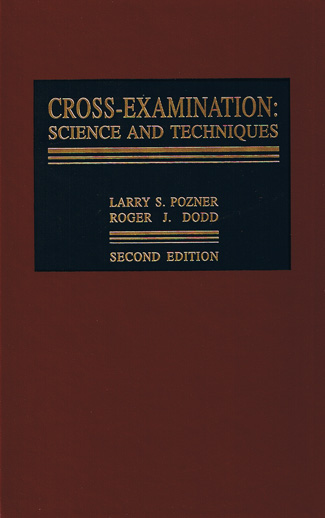Cross-Examination: Science and Techniques 2nd ed with 2012 Cumulative Supplement
ISBN13: 9780327164340
Published: October 2012
Publisher: LexisNexis Matthew Bender
Country of Publication: USA
Format: Hardback & Supplement
Price: Out of print
In Cross Examination: Science and Techniques 2nd ed, Larry Pozner and Roger Dodd continue their outstanding tradition of helping attorneys conduct commanding cross-examinations.
The second edition offers deeper analysis of cross-examination methods, with more integration and interrelationship of techniques and principles.
The authors recognize that trials and juries have changed considerably since the publication of the First Edition in 1993. Evolving admissibility standards and the Internet age pose new challenges to the cross-examiner.
In analyzing thousands of new trial experiences, Pozner and Dodd present efficient techniques to confront these challenges, and ultimately, help attorneys develop cross-examination skills that are critical to trial success.
- The 2012 Supplement was published in March 2012
- The 2010 Supplement was published in November 2010
- The Main Work was published in December 2004
In this new Second Edition, the authors:-
- Demonstrate how opponents' objections can be the springboard for deeper and broader cross-examinations.
- Show how cross-examination can be sequenced to teach the theory of the case in the best way, and to literally expand the rules of admissibility.
- Explain how "loops" (the practice of incorporating and repeating key phrases and terms in successive questions to the witness) are used to rename witnesses and exhibits.
- Describe the use of "double loops" to discredit opposing expert witnesses.
Effective cross-examination is a science with established guidelines, identifiable techniques, and definable methods. Attorneys can learn how to control the outcome with careful preparation, calculated strategy, effective skills, and a disciplined demeanor.
The book also includes explanation of how to:-
- Use voir dire to create great jurors
- Use a fact-driven investigation to develop a winning theory
- Use a witness's own words to follow your theme and theory
- Control the runaway witness
- Communicate winning theories in opening, cross, and closing
- Use loops to box in the witness
- Use tactical sequencing to create the most powerful cross
- Convert a witness's silence into admission of fact
- Induce the witness to voice your pre-selected words
- Prepare for devastating impeachment
- Close off any escape routes for the witness
- Punish the evasive or "I don't know" witness
- Control the crying witness
- Use timing, posture, inflection, diction, wording, eye contact, and other effects to emphasize a witness's concession
This revised and improved resource addresses new challenges and offers deeper analysis of cross-examination methods. Pozner and Dodd's book remains the definitive guide to preparing killer cross-examinations.
The 2012 Cumulative Supplement now includes an exciting new chapter:-
- Value-Based Cross-Examination
- Support your cross by damaging the credibility of the witness.
- Establish a value that the witness with subscribe to.
- Expose witness conduct that is inconsistent with those values.
